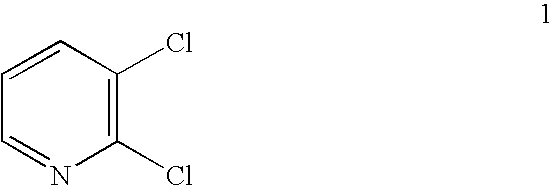Process for the manufacture of 2,3-dichloropyridine
a technology of pyridine and pyridine, which is applied in the field of 2,3-dichloropyridine production, can solve the problems of severely limited use of the reported method
- Summary
- Abstract
- Description
- Claims
- Application Information
AI Technical Summary
Problems solved by technology
Method used
Image
Examples
example 1
Preparation of 2,3-dichloropyridine 1
[0130] To a 300-mL sidearm flask was charged 12.8 g (0.10 mmol) of commercial 3-amino-2-chloropyridine 2, 30 mL of water, and 30 mL of 37% aqueous HCl. After the mixture was cooled to −8° C. (a slurry forms), a solution of 7.0 g (0.10 mol) of NaNO2 in 14 mL of water was added over 30 minutes at −7 to −3° C. The orange solution became a thin yellow suspension towards the halfway-point of the addition. After the addition, the mixture including the diazonium chloride salt was transferred to a jacketed addition funnel at 0° C. The diazonium chloride salt mixture was added dropwise to a flask containing 20 mL of 37 % aqueous HCl, 60 mL of n-BuCl, and 4.5 g of CuO at 55-62° C. under nitrogen.
[0131] The reaction mass was diluted with 100 mL of water and the n-BuCl layer was separated, washed with water, and concentrated to dryness to yield 13.8 g crude 2,3-dichloropyridine 1 as a pale yellow solid (92% yield) with 98% purity.
example 2
Preparation of 3-amino-2-chloropyridine 2 using hydrogen peroxide
[0132] 3-Aminopyridine 3 (30.0 g, 0.32 mole) was add to 300 mL of 37% aqueous HCl in a 1-L Morton flask with overhead stirring at about 30-35° C. After the mixture was cooled to about 10° C., 23 g (0.34 mol) of 50% hydrogen peroxide was added over 20 minutes at about 10-12° C. The mixture was held at about 10° C. for 2 hours and then was allowed to warm to about 19° C. over 2 hours and held at that temperature for additional 4 hours. HPLC analysis showed approximately 90% conversion of 3-amninopyridine 3. After cooling the reaction mixture to 10° C., a solution of 6 g of sodium sulfite in 50 mL of water was added. To the mixture were added 50 mL of toluene and 200 g (2.5 mol) of 50% aqueous sodium hydroxide at about 25-35° C. Then water was added to dissolve precipitated NaCl, and the layers were separated. The organic phase was back-extracted with 45 g of 10% aqueous HCl to recover some 3-amino-2-chloropyridine 2 in ...
example 3
Preparation of 3-amino-2-chloropyridine 2 using chlorine
[0133] 3-Amninopyridine 3 (21.0 g, 0.223 mol) was added to 90 mL (ca. 108 g, 1.08 mol) of concentrated aqueous HCl (ca. 37%) in a 300-mL sidearm flask with magnetic stirring at 30-35° C. The mixture was cooled to 15° C. (thick slurry) and chlorine gas was sparged just above the surface over about 1.5 hours at 15-20° C. HPLC analysis showed approximately 93% conversion of 3-aminopyridine 3. The mixture was cooled to 10° C. and a solution of 6 g of sodium sulfite in 50 mL of water was added. To the mixture was added 30 mL of toluene and 80 g (1.0 mol) of 50% aqueous sodium hydroxide at about 25-40° C. Then water was added to dissolve precipitated NaCl, and the layers were separated. The aqueous phase was extracted once more with 30 mL of toluene. To the aqueous phase was added 10 g of 50% NaOH, and extracted with another 50 mL of toluene to remove 3-amino-2,6-dichloropyridine. The combined organic phase was back-extracted with 4...
PUM
| Property | Measurement | Unit |
|---|---|---|
| temperature | aaaaa | aaaaa |
| mole ratio | aaaaa | aaaaa |
| mole ratio | aaaaa | aaaaa |
Abstract
Description
Claims
Application Information
 Login to View More
Login to View More - R&D
- Intellectual Property
- Life Sciences
- Materials
- Tech Scout
- Unparalleled Data Quality
- Higher Quality Content
- 60% Fewer Hallucinations
Browse by: Latest US Patents, China's latest patents, Technical Efficacy Thesaurus, Application Domain, Technology Topic, Popular Technical Reports.
© 2025 PatSnap. All rights reserved.Legal|Privacy policy|Modern Slavery Act Transparency Statement|Sitemap|About US| Contact US: help@patsnap.com



